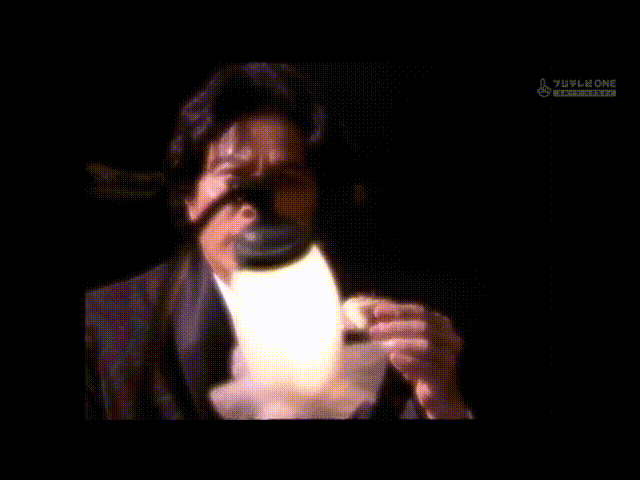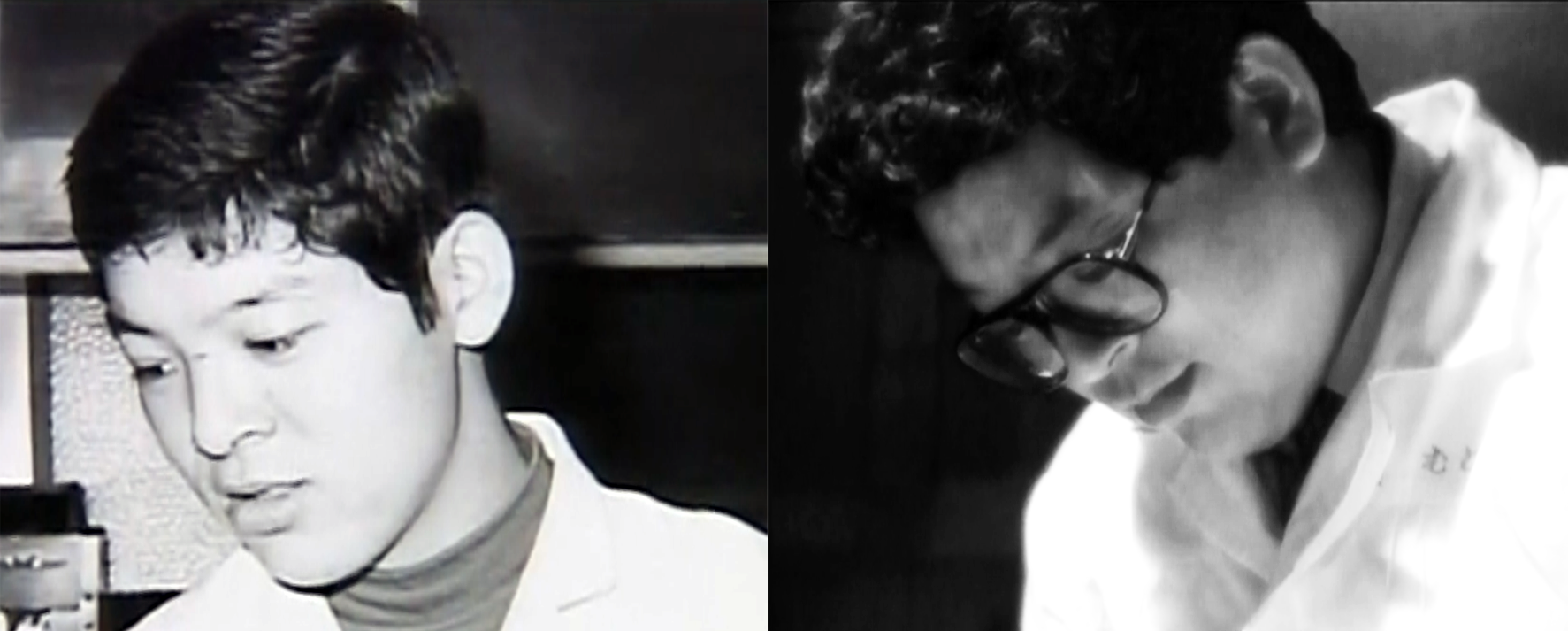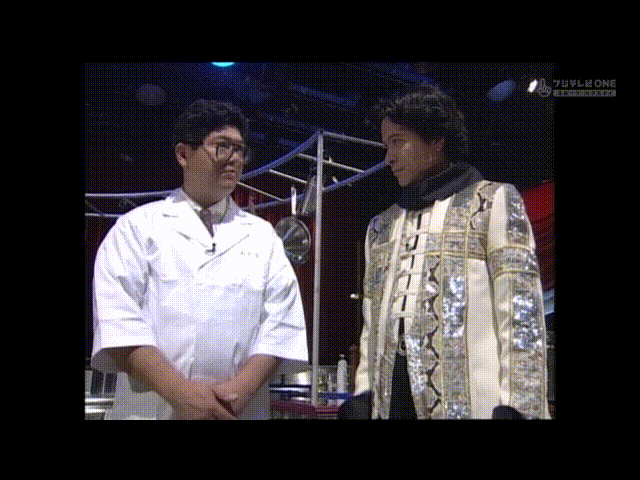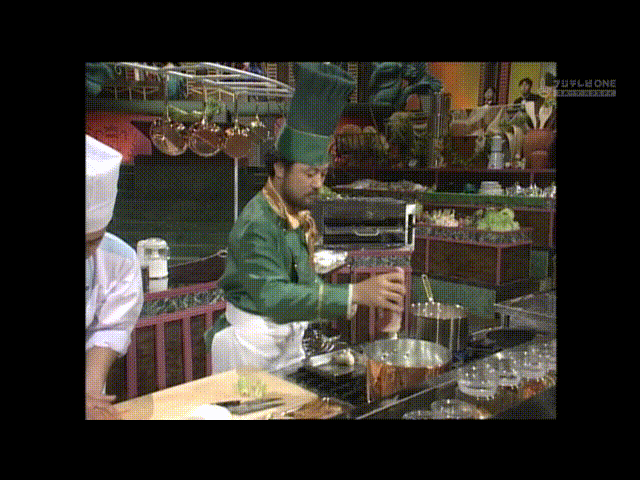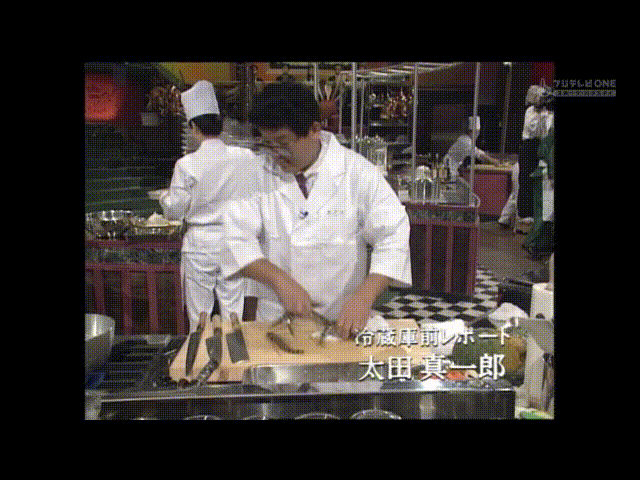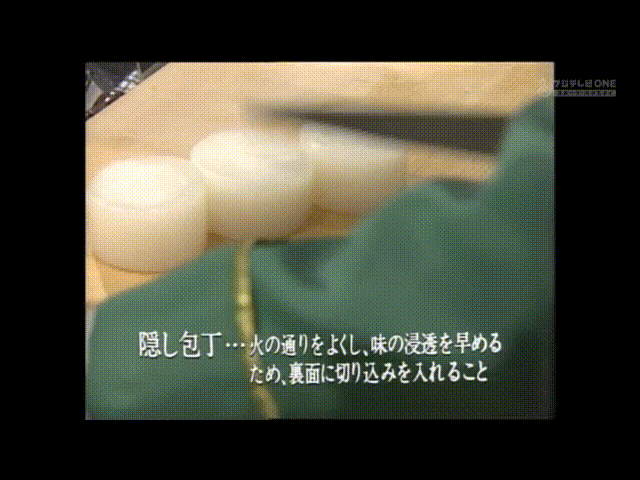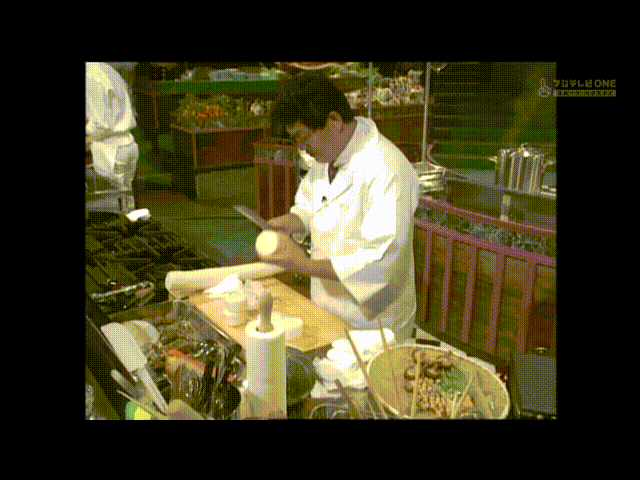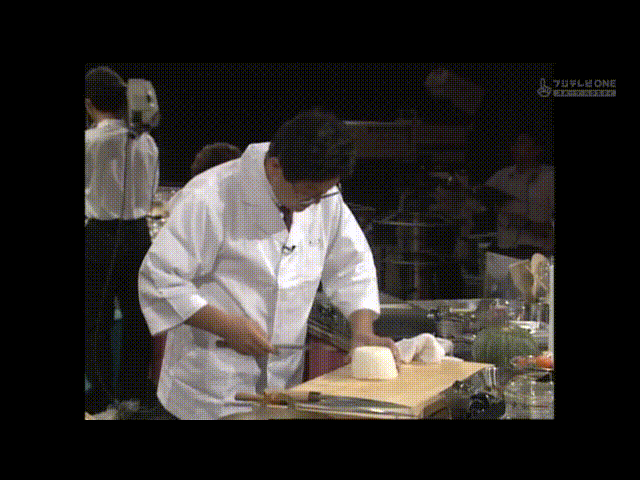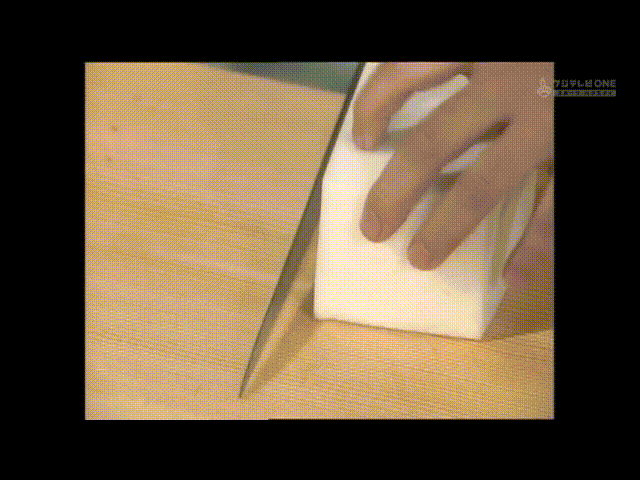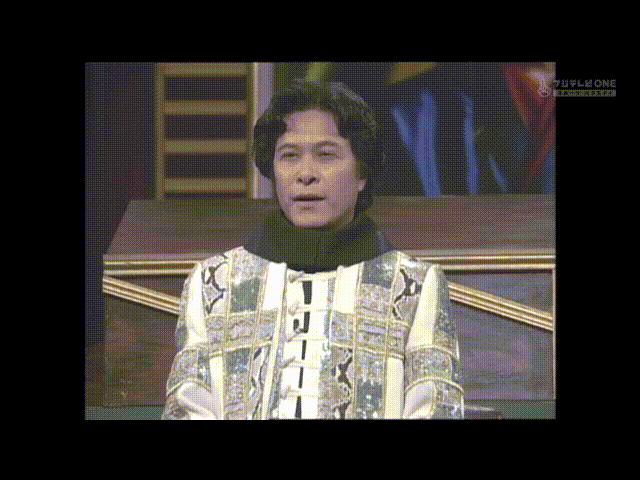Iron Chef #7 - Daikon Radish Battle
The stuffiness dreams are made of.
Challenger Masato Muto vs Iron Chef French Yutaka Ishinabe
Iron Chef 1993 Episode 7 - Overall episode #007 - November 28th, 1993
This is going to be a pompous battle with a modest ingredient.
Before we get into the negatives, there are a few things to love about this battle:
1) No more play-in tournament.
Using Iron Chef Kenichi’s loss in the previous “lost” episode as justification, the Chairman has eliminated the play-in tournament. For the first six episodes, five challengers would compete in a yoshoku challenge, with the winner advancing to the Iron Chef battle.
The play-in tournament was a good thought, and could have worked in an hour format. The stakes aren’t high enough in the play-in worth sacrificing 5-minutes (runtime) of the main battle. The typical play-in only features three professional Chefs, with the remainder being anywhere from high school students (we’ve had two) to make up artists. You can’t side-hustle your way to defeating an Iron Chef.
Great format change. The show is better off for it.
2) This is the only ingredient under $10/lbs since tofu thus far this season.
This both makes the show more accessible and makes the luxury episodes feel extra special.
I don’t mind lugging home a two pound daikon from the supermarket to try out some stuff. You better believe I’m trying the radish steak Iron Chef Ishinabe demonstrates this battle. When I fail, it will have cost me nothing.
3) The versatility of the daikon ranks near the top with tofu this season.
The mild daikon radish can be served raw in salad, pickled in a banh mi, fermented for mu kimchi, boiled and braised for soups and stews where it gets fall-apart tender, or even grated for marinades and sauces.
Daikon wraps are my absolute favorite KBBQ banchan. I load those up like a taco.
“Turnip” cake in dimsum? That’s daikon, and daikon should take legal action against turnip. I didn’t realize how much I take daikon radish for granted. Fantastic ingredient.
Let’s turn our attention to the very disappointed elephant in the room. Both chefs are the most constructionist, restrained, and “haute” in their respective cuisines.
Our Iron Chef, while cool and casual in demeanor, serves white tablecloth French classics on cruise-control. Our challenger, though projecting a mad scientist vibe, specializes in the highly restrained and minimalistic pine-table washoku Japanese cuisine.
Washoku is something special. It is seasonal, highly structured, and showcases the ingredients. Classic French cuisine is celebrated worldwide for a reason; it is washoku with less structure and more calories.
So, what is the problem?
Both chefs go so far down the rabbit-hole of their respective cuisines that they brunois their way to the same warren. Instead of a Muto vs Ishinabe battle, nor a French vs Washoku battle, we are culinary school instructors grading students in a pretentious technique battle.
We will learn a lot of verbiage today that all sound like Final Fantasy limit-breaks: tourne, allumette, chamfer, takiawase, and hidden-knife (seriously).
Unfortunately, we will not learn the one technique we should be: Katsuramuki, in which chefs peel the daikon into a long continuous sheet using a chef’s knife. Ask future Iron Chef Morimoto about Katsuramuki. It is not important because of the knife stunt (anyone who values their fingers wouldn’t try it at home). It is important because it is satisfying to watch. It’s like a perfectly mowed outfield. A perfect parallel park. The gradual unraveling of an even paper-thin translucent sheet of radish feeding out from a nikiri-knife like a dot-matrix printer is zen. It is disappointing neither chef attempted this technique.
Save your sprouts and brush up on your French for this stuffy, formal, pompous, stodgy,… radish episode?
Format Change!:
The Chairman contemplates the sense of having a 5-minute runtime (hours real-time) play-in tournament to select a challenger to face an Iron Chef for the remainder of the episode. He knows what he must do: Dispatch four of this week’s challengers with his letter opener (cleaver).
After dispensing with the unpleasantries (four of them, to be exact), the Chairman is pleased with his decision. The show is stronger for it.
Meet the Challenger:
Masato Muto
Chef Muto specializes in washoku kaiseke. One of the most structured and traditionalist cuisines in the world. He is considered the “bad boy” of washoku, once using Osakazuke Japanese maple leaves as a garnish instead of Beni Kawa Japanese maple leaves! You should have seen everyones’ faces.
Chef Muto opened his own restaurant in Ginza at he age of 30, later opening up washoku kaiseki restaurants Meguro Muto at 39, and Akasaka Muto at 40.
The Mad Scientist of washoku cuisine.
Once Chef Muto made a sauce of 2 tablespoons soy sauce, 2 teaspoons rice vinegar, and 1.25 teaspoons of mirin when the recipe said only 1 teaspoon mirin! It took months of self-flagellation to recover.
Challenger Muto’s Sizzle Reel:
Truffles and alginate spherification. We may have our first modernist chef to grace Kitchen Stadium, well… since the Chairman’s “meat glue” experiment / disaster / criminal proceedings.
This is very bright, busy, colorful, and topped with expensive accoutrements. It is an unexplainable spectacle. This is a Marvel film on a plate.
Another nature forward dish. We can expect seasonality to be a theme in Chef Muto’s washoku cuisine. The challenger should excel with daikon radish.
Showdown:
Challenger Masata Muto vs Iron Chef French Yutaka Ishinabe!
Chef Muto makes a lucky but determined choice in challenging Iron Chef French Ishinabe. Neither Muto nor the Iron Chefs know today’s secret ingredient, so I don’t think it was a deliberate strategy.
It just so happens that Iron Chef Japanese Michiba and Iron Chef Chinese Kenichi both excel at cuisines featuring the daikon. Whereas, Iron Chef French Ishinabe likely just uses the sprouts to garnish a puree’d soup, and the bulbs to throw at advancing Germans.
Tale of the Tape:
Challenger Masato Muto vs Iron Chef French Yutaka Ishinabe!
The Chairman’s Fit:
Speaking of the Chairman's fit, I'm glad you asked
Today the Chairman is working security for Michael Jackson’s 1993 “Dangerous” world tour. You can slip him ¥15,000 to get backstage, or ¥1,000,000 to replace half of Kriss Kross for the opening act. Either Chris, it doesn’t matter to Chairman Kaga.
The Reveal:
Daikon!
The Chairman exhibits the secret ingredient with the usual enthusiasm. It doesn’t matter if the ingredient is white truffles or white radish, Chairman Kaga values all non-human life.
Challenger Muto is happy with the secret ingredient. Iron Chef Ishinabe is not. Ishinabe reflects back on his last time encountering a daikon. It was 1988, Super Mario Bros 2 on NES. A then 40-year old Ishinabe would pluck daikons with the B-button and throw them at his enemies. A strategy he is strongly considering today.
There are two types of daikon being offered today. Aokubi are the long white carrot shaped daikons. Shogoin are the rounder Kyoto variety.
The Chairman's Wisdom:
“It tastes better than it looks.”
True of most root vegetables. Except parsnips. Parsnips invariably look better than they taste.
The b-roll was Akusaka Shinto pagoda, boiled daikon with gold leaf, simmering daikon, and a daikon farm.
Profound.
Allez! Cuisine!:
The Chairman can barely suppress a giggle, for he shuffled in a turnip amongst all the radishes. The first chef to find it replaces the other Chris in Kriss Kross for the Australian leg of the “Dangerous” tour.
In the Booth:
Play-by-Play Kenji Fukui (right) and Color Commentator Dr. Yukio Hattori (left) are in the booth. These are the untranslated episodes so we only have to assume the following exchange took place:
Fukui: The USDA's official name for the daikon is the "Oilseed Radish."
Dr. Hattori: The USDA also allots for a daily cheeseburger and fries in it's food pyramid. 1994 conventional wisdom be crazy.
Fukui: Right you are, Doc! Let’s never leave this golden age of cheeseburgers.
The Battle:
Challenger Muto opens his case of knives. He is prepared for everything. Everything. *Lifts glasses and winks for emphasis*
Both Iron Chef Ishinabe and Challenger Muto are preparing cross-sections of the Aokubi daikon. Disappointingly, we do not get an attempt at katsuramuku, but a stuffy French “chamfer” from both chefs (see Knife Life for more on the chamfer battle within a battle).
Iron Chef Ishinabe throws in a slab of prok belly to boil, ponders restraint, and then throws in a second slab of pork belly. Chef’s Kiss.
Challenger Muto utilizes ring molds to punch out daikon flowers that will later be rendered into circular mush after an hour of boiling. He would have a difficult time getting the daikon to the desired tenderness while maintaining its delicate flower shape.
Iron Chef Ishinabe, not content with just pork, throws a whole chicken into the stock pot as well. While it looks like he’s building a nice stock, which he is, the goal is to plate a whole poached chicken with tourne’d vegetables on a platter.
Iron Chef Ishinabe has thin planks of daikon and a very large quantity of salt. Pickled radish incoming. Challenger Muto is taking a similar approach with his circular daikon wraps.
Challenger Muto is giving these spectacular live tiger prawns the spa treatment.
Challenger Muto shucks some giant Japanese oysters. Pork and chicken from the Iron Chef. Shrimp and oysters from the challenger. Land vs Sea daikon battle.
Challenger Muto’s daikon flowers and daikon chamfers have been boiling under an otoshibuta (Japanese drop lid). The intent is to keep the contents of the pot stable and prevent erosion of the sculpted edges of the daikon as they boil. Unfortunately, this was not entirely successful.
Iron Chef Ishinabe’s pork is looking tender as he drops it into a pot of tourne’d root vegetables (potatoes, carrots, and daikon). “Tourne” is a French technique in which a Chef delegates cutting vegetables into the shape of footballs to the subordinates they dislike the most (“L’imbécile”).
Iron Chef Ishinabe has a mustard vinaigrette reserved for a salad. The salad will probably come together in the final minutes. It doesn’t appear there is grated daikon in this dressing, which would be a missed opportunity.
One, two, three, four… Only four more episodes, then the Chairman calls off the debt. I’ll see you soon, Grand-mère….
Challenger Muto decides to tourne daikons as well, throwing them into a pot with the chamfered daikons, and flower-shaped daikons. This Lucky Charms of daikon shapes are being drop-lid simmered in un dashi mystérieux.
The “hidden knife” technique in which the ingredient is sliced partially through to quicken cooking time but not hamper presentation. The hidden knife may not appear overtly French, but was heavily featured in Assassin’s Creed Unity.
Listen here, pantry. Four more episodes. After that, I’m in Havana with a new name and new passport. I’ll miss you all. Especially you, jar of star anise. Keep it gutta.
I miss Star Anise already. Don’t get me started on Bae Leaf. I’M FINE.
Daikon oyster wraps is the first confirmed dish from the challenger. Those are going to be folded like the bivalves they came from and steamed.
Shrimp daikon wraps with sudachi will accompany the oyster wraps. No indication yet where all the simmering geometric daikons are going.
Iron Chef Ishinabe browns the chamfered and hidden-knifed daikon in half a stick of butter. Radish steaks incoming. The saucing and presentation is going to make this “steak” work.
I wonder if the Chairman will allow me to keep this outfit. It is my only set of clothes.
Challenger Muto’s oyster and shrimp daikon wraps were steamed and then plated back in the giant oyster shell. Great presentation and looks like a good bite.
Iron Chef Ishinabe’s chamered daikon was browned in butter, and now is getting a porto-sake and chicken stock reduction. Porto-sake is made by adding brandy to rice wine, and just sounds fantastic.
Challenger Muto’s second dish is coming together as a kaiseke takiawase, in which multiple individually simmered ingredients are served together in a dashi. We’ll have a root vegetable (daikon, carrot, taro, and lotus root) and shiitake soup. Sadly, the daikon flowers did not make it to the bowl. Some pork riblets would go a long way here, but we haven’t seen the challenger reach for any land-based proteins yet. Depending on the dashi, this dish could be vegetarian.
Iron Chef Ishinabe plates a last-minute salad of pickled daikon “noodles,” marinated scallop skirts, and ring of regrettable tomato wedges. This will be doused in the mustard vinaigrette from earlier. The Iron Chef will have three dishes opposed to the challenger’s two dishes.
That Knife Life:
Iron Chef Ishinabe is chamfering daikon cross-sections into perfect rounds with a paring knife. “Chamfer” is a French technique deriving from the word “Chamfrain” meaning “to hide one’s obsessive compulsive disorder behind piles of vegetable scraps.”
Challenger Muto enters the chamfer championship with his nikiri.
Challenger Muto slices translucently-thin daikon wraps. I could watch this all day.
Iron Chef Ishinabe is slicnig some paper-thin planks of his own.
Iron Chef Ishinabe allumettes the heck out of that daikon. Fantastic allumetting. Today I learned “allumette” is a French technique meaning “to cut something into matchsticks, but pretentiously.”
The Judges’ Table(s):
J-Pop record producer Yasushi Akimoto (22 battles).
Still refers to himself as the Don Juan of Daikon, even though the royalties dried up ages ago.
Actress Yoko Asaji (3 battles).
Replaced judge Emi Inoue, who mysteriously disappeared after Battle Lobster. Judge Asaji just happened to be in the neighborhood, on a jog, with contractor-size garbage bags and zip-ties.
Rosanjin scholar Masaaki Hirano (42 battles).
Sleeps in Kitchen Stadium’s pantry. Not because of poverty, but because of a philosophical embrace of poverty (and all the vanilla extract he can drink).
Dishes:
Challenger Muto completes two dishes and a sauce:
Challenger Muto’s first dish:
Radish-wrapped Oyster and Shrimp
Daikon-wrapped oyster and daikon-wrapped shrimp served in a giant oyster shell with a basil leaf. A light dashi was spooned over. Good sakizuke starter for this mini-kaiseke, Not much feedback from the judges, who were all partial to the challenger’s second dish.
Challenger Muto’s second dish:
Fukiyose
The takiawase course of the kaiseke, fukiyose offers upwards of 10 seasonal ingredients of various shapes, colors, and textures. All of the ingredients are individually simmered.
High effort dish, but the daikon is going to get lost being 10% of the components. There’s no evidence of the daikon flowers nor chamfered daikon. All that technique didn’t make the plate.
Regardless, we get a double-oishi from judges Akimoto and Asaji. Judge Hirano instead shares his theory on how the Gregorian calendar is a conspiracy to steal the very concept of time.
Iron Chef Ishinabe completes three dishes:
Iron Chef Ishinabe’s first dish:
Radish and Scallop Salad
Iron Chef Ishinabe’s unique last-minute salad serves as his starter. The Japanese influence is evidenced in the daikon noodles and marinate scallop skirts. The French influence is evidenced by the mustard-vinaigrette and bell pepper julienne. The food court influence is evidenced by the ring of tomato wedges. Judge Akimoto gives Ishinabe his only oishi of the day.
Iron Chef Ishinabe’s Second Dish:
Radish Pot au Feu
A chicken-based pot au feu. Iron Chef Ishinabe’s most time consuming dish between boiling a whole chicken and the vegetable tournes. The slab of pork belly will help the otherwise thin broth. This was a dish with one purpose: demonstrate superior stodgy French classical technique. The judges skip right past this, likely because the tablecloth looked more exciting than the plated dish.
Iron Chef Ishinabe’s third dish:
Radish Steak with Port Sauce
The Iron Chef’s win or loss hinges on the success of this dish. The competition is pretty close, with a slight edge going to the Challenger for his fukiyose. If this eats anyything like a steak, I expect the judges to award the victory to the Iron Chef.
On camera, the daikon steaks were scored, browned in butter, and cooked in a port-sake and chicken stock reduction. Off-camera, the sauce looks to have been mounted with cream.
The judges are both confounded and delighted by the radish steaks. They seem impressed more by the conceptualization than the taste, as only judge Asaji went back for a second bite.
Whose cuisine reigns supreme?!
Iron Chef Ishinabe!
That was a close battle.
Challenger Muto led in oishis, Ishinabe led in dishes. Both presented technique-driven conservative food, with the Iron Chef being slightly more bold and flexible in his approach. There is little room for port-sake and heavy cream reductions in washoku.
That being said, the challenger lost due to technique, not his ascetic principles. This is surprising given the litany of knife skills and French verbiage demonstrated this episode. Unfortunately, the challenger’s daikon flowers and chamfered daikon presumably fell apart in an hour of boiling. The crisp shapes he painstakingly shaved turned rounded and mushy until the boiled radish was indistinguishable from a boiled edo root.
Iron Chef Ishinabe, in his fifth to last episode, was in cruise control (per usual). The salad was confusing, but the other two dishes hit the classic French wheelhouse, and was overall a more “fun” meal.
Episode notes:
My favorite dish was Challenger Muto’s daikon wraps. Though I will be attempting Iron Chef Ishinabe’s daikon steaks as well.
This was the first of two daikon radish battles. Coincidentally, the next one features a French vs Japanese cuisine matchup as well.
For a better survey on washoku cuisine, check out Washoku, Elizabeth Andoh’s cookbook.
The USDA has no longer subscribed to the food pyramid since 2011.
Next up, episode #008 - Crab!



